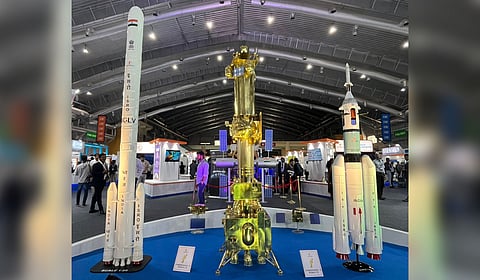Chandrayaan-4 mission model unveiled at Bengaluru Science Expo
BENGALURU: The model of Chandrayaan 4 mission, aiming to return Moon rocks and soil (regolith) to Earth, was displayed for the first time to the public at the Bengaluru Science Expo on Wednesday. Alongside the Chandrayaan 4 model, ISRO also displayed the Next Generation Launch Vehicle (NGLV) and the Human-Rated Launch Vehicle MK3 (HRLV).
An ISRO official told TNIE that the Chandrayaan 4 mission -- designed to land on the lunar surface, collect samples and return them to Earth -- features five key modules, divided into two stacks. “Stack 1 consists of the Ascender Module and Descender Module, both responsible for collecting lunar samples.
Stack 2 includes the Propulsion Module for thrust, the Transfer Module to receive and hold the samples, and the re-entry module to bring them back to Earth,” the official explained.
ISRO to come up with cost-effective models
The official said the mission will feature docking, joining two spacecraft in space, and undocking operations (separating them) while orbiting the Moon. The mission will utilise two rockets -- the Launch Vehicle Mark-3 (LVM-3), which is a heavy-lifter designed to carry large payloads, and the Polar Satellite Launch Vehicle (PSLV), known for its reliability. Each rocket will transport a different part of the mission’s equipment to the Moon. The spacecraft will connect and disconnect in Moon orbit, with one rocket carrying heavier equipment and the other carrying additional payloads.
Across its centres, ISRO is working to develop cost-effective models with ‘stack modules’ to enable more research launches in less time, the official added.
At the expo, ISRO also showcased the Bharatiya Antariksh Station (BAS-1), conceptualised by ISRO Chairman Dr S Somanath which is a key component of the Gaganyaan programme’s expansion. The model was recently exhibited in New Delhi on the National Space Day.
The ISRO official said that due to the complexity of the project, not all components can be launched together. Instead, different modules will be launched separately by various rockets and then assembled in orbit.
In BAS, the docking process will involve different spacecraft bringing in various modules. Once assembled, the BAS will allow for collaboration between students and other space agencies for space experiments. The BAS will orbit Earth at a distance of 100 km by 100 km. It is designed to be visible to the naked eye, much like the International Space Station (ISS), and will even support ISS operations by appearing as a moving star in the sky, the official added.
The official said BAS development is progressing well.

